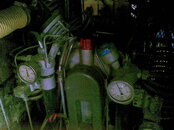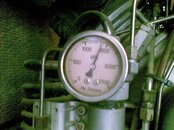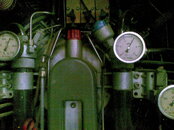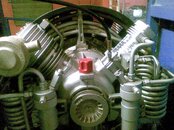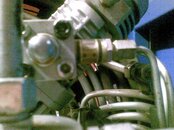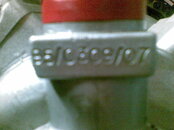You are using an out of date browser. It may not display this or other websites correctly.
You should upgrade or use an alternative browser.
You should upgrade or use an alternative browser.
Air bubbles in the oil........
- Thread starter widget
- Start date
Please register or login
Welcome to ScubaBoard, the world's largest scuba diving community. Registration is not required to read the forums, but we encourage you to join. Joining has its benefits and enables you to participate in the discussions.
Benefits of registering include
- Ability to post and comment on topics and discussions.
- A Free photo gallery to share your dive photos with the world.
- You can make this box go away
pescador775
Contributor
- Messages
- 2,652
- Reaction score
- 14
Shimming would just increase oil pressure. In fact, very old regulators did not have a screw adjustment, just shims. I don't know what to tell you at this point but will mull it over.
Pescador / craig, today we rigged up an interstage pressure gauge to see how each individual stage performs, the first three stages are perfect, its only when the interstage pressure gets to 80 bar that the oil foams in the sight glass.
So will this not point to a fault on the fourth stage somewhere (I dont know where, we have stripped it down and checked everything 3 times at least) - from my info the fourth stage kicks in at 80 bar, so I figure it like this, as soon as the air pressure 80 bar overcomes the oil pressure 60 bar we get foaming.
Dos this sound right? Its not valves, its not the head, that leaves the piston and liner or the pressure regulator. Any ideas?
So will this not point to a fault on the fourth stage somewhere (I dont know where, we have stripped it down and checked everything 3 times at least) - from my info the fourth stage kicks in at 80 bar, so I figure it like this, as soon as the air pressure 80 bar overcomes the oil pressure 60 bar we get foaming.
Dos this sound right? Its not valves, its not the head, that leaves the piston and liner or the pressure regulator. Any ideas?
Widget, look at the last two digits of the K14 block numbers. If I recall, you said you had two of them. You will see this number embossed in the crank-case to the right of the oil fill. It should look something like this 88/3457/06. The last two digits note the modification number and if they are the same, the oil regulators should be inter changeable. Any chance of digital pics of the two blocks?
Again, I still think it is the oil regulator.
Craig
Again, I still think it is the oil regulator.
Craig
pescador775
Contributor
- Messages
- 2,652
- Reaction score
- 14
A compressor works on pressure ratios. These ratios are calculated using something called the rule of squares which in its simplest form is used to design two stage compressors. Based on simple equations using this principle, the design engineer, in effect, couples two, 2 stage compressors to make a four stage. The relationship between the sizes of the stages produces the ratios. As with all stages, the third stage produces its specified pressure only after its contents are dumped into the fourth stage. This happens while the smaller fourth stage is bottoming. So, the third stage develops its rated pressure due to the compression of its gas load into the smaller volume of stage four. The fourth stage produces pressure in accordance with the load. In other words, the pressure inside the fourth stage rises in concert with the back pressure or that inside the SCUBA tank. The spring loaded discharge valve of the 4th stage plus some level of back pressure will ensure that some pressure will develop inside that cylinder at start and when the back pressure rises a little bit and the piston stops banging it is operating normally. However, it will not hold all of the pressure which should develop based on ratios until the back pressure rises to a certain level. This is the reason that stage pressure varies. When the third stage dumps its load into stage four some of this gas blows on through while the piston is falling and simultaneously the balance of internal pressure serves to drive down the piston. When the pressure at the back pressure valve or inside the scuba tank approaches the third stage design pressure (1100 psi) there is higher back pressure on the discharge valve and no more blow through at the fourth stage discharge valve; so, the fourth stage pressure rises while the third stage should remain relatively steady. At this point, the specified interstage pressures should all be close to that listed in the manual. However, due to valve leakage or overlap among the stages these values could continue to vary somewhat, rising with delivery pressure. The point of this is that the fourth stage load is shared, so to speak, with the third stage until delivery pressure rises to a crucial level. I think that this is what you are referring to.
I think so Pescador  . I am a little lost there, but I think thats pretty much it, as soon as the fourth stage takes over the load, it foams the oil.
. I am a little lost there, but I think thats pretty much it, as soon as the fourth stage takes over the load, it foams the oil.
Craig, I will take a pic and post the two numbers tomorrow, I know the ones you are referring to, but one unit (the one giving issues) is a K14 -10 and the other a K14 - 12the blocks look identical.
tHE k14 -12 is a newer machine - I understand the 10 or 12 refers to the model series which went up to 15 before the design was superceeded by the K15.
The K14 -12 is a bit differant internally as it uses a piston and liner which has an o-ring seal to the head - the 10 model is metal to metal - other than that I undertand them to be the same.
The regulators look identical, I can try and swop em, I didnt do it before because we rebuilt it.
Craig, I will take a pic and post the two numbers tomorrow, I know the ones you are referring to, but one unit (the one giving issues) is a K14 -10 and the other a K14 - 12the blocks look identical.
tHE k14 -12 is a newer machine - I understand the 10 or 12 refers to the model series which went up to 15 before the design was superceeded by the K15.
The K14 -12 is a bit differant internally as it uses a piston and liner which has an o-ring seal to the head - the 10 model is metal to metal - other than that I undertand them to be the same.
The regulators look identical, I can try and swop em, I didnt do it before because we rebuilt it.
When someone mentions K14-10 or K14-12, the distinction lies in the hp of the motor (electric) as the K14 can be run with either a 7.5HP or a 10HP. Lower output vs higher output. The blocks are the same, unless the modification numbers are different.
Craig
Craig
That is correct. I'm thinking the last Mod version, last two numbers on the block, for the K-14 was either "07" or "08", please correct me if I'm wrong. I had an older "mod 03" and our newer one, 1998 model, shows "08". Is the only difference between the Mod 07/08 versus the older ones is the newer use the different 1st stage head?
Perhaps, Bauer locally has their own numbering system, but I certainly have a model 10 (with issues) and a model 12 working fine.
I have had a murderous 4 days at "the office", just no time to download the pics, now when I do have time, the cable is missing, I am going to "raid the pantry" for another and will try again later today when I can find one.
I have had a murderous 4 days at "the office", just no time to download the pics, now when I do have time, the cable is missing, I am going to "raid the pantry" for another and will try again later today when I can find one.
Okay, uploaded a few shots, the first three are of the unit thats running, and the second three of the unit thats sitting.
The serial number is quite visible and the oil sight glass is where we see the foaming.
Now yesterday, we found oil globules been forced out of the over pressure valve on the seperator just after the fourth stage, so oil is going in here as well.
Someone mentioned perhaps the Corena is too light and we should use a more heavy oil, could this be the issue, sounds a bit remote to me.?
Sorry about the poor quality, but I only have a mobile phone camera here and its not the best one at that.
Okay, gotta run, work calls, will answer any further quesies later.
The serial number is quite visible and the oil sight glass is where we see the foaming.
Now yesterday, we found oil globules been forced out of the over pressure valve on the seperator just after the fourth stage, so oil is going in here as well.
Someone mentioned perhaps the Corena is too light and we should use a more heavy oil, could this be the issue, sounds a bit remote to me.?
Sorry about the poor quality, but I only have a mobile phone camera here and its not the best one at that.
Okay, gotta run, work calls, will answer any further quesies later.
Attachments
Similar threads
- Replies
- 24
- Views
- 1,585
- Replies
- 8
- Views
- 726
- Replies
- 1
- Views
- 301
- Replies
- 33
- Views
- 2,157
- Replies
- 11
- Views
- 1,034



